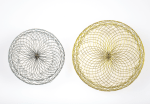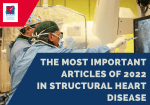Left atrial appendix closure (LAAC) has become a frequent intervention for stroke prevention in patients with atrial fibrillation (AF) that make poor candidates for anticoagulation. However, it presents a complication with negative impact on procedural outcomes which is peridevice leak. To reduce these complications, we use intra-procedural imaging, the transesophageal echocardiogram (TEE) being the most<a href="https://solaci.org/en/2023/03/02/intracardiac-echocardiography-to-guide-watchman-left-atrial-appendix-closure-safe-and-effective/" title="Read more" >...</a>
FLASH Registry: Mechanical Thrombectomy with FlowTriever
Prospective registry of PTE patients who underwent FlowTriever, with 6 months of follow-up. The clinical relevance of interventional treatment in pulmonary thromboembolism (PTE) is often discussed, and no clinical studies have demonstrated a decrease in “hard” outcomes such as mortality. However, in recent years the use of catheter-directed therapies has increased, either through its main indication,<a href="https://solaci.org/en/2023/03/02/flash-registry-mechanical-thrombectomy-with-flowtriever/" title="Read more" >...</a>
Uncomplicated Type B Aortic Dissection
Mortality Assessment, Interventions and Hospitalization in Patients with Uncomplicated Type B Aortic Dissection with TEVAR. Over 60% of type b aortic dissections present with no complications, such as signs of imminent rupture or already established poor perfusion. Most uncomplicated type b aortic dissections (uTBAD) are managed with medical treatment to control pain and limit the<a href="https://solaci.org/en/2023/02/08/uncomplicated-type-b-aortic-dissection/" title="Read more" >...</a>
The most read articles of january in solaci.org
These were the most read articles of interventional cardiology in solaci.org. Real-World Revascularization Strategy for Left Main Coronary Artery: Surgery or PCI? There are many current randomized trials comparing percutaneous coronary intervention (PCI) with myocardial revascularization surgery (MRS) for the treatment of left main coronary artery disease (LMCAD). Real-World Results of Different Devices for TAVR Transcatheter aortic valve replacement (TAVR) keeps<a href="https://solaci.org/en/2023/02/06/the-most-read-articles-of-january-in-solaci-org/" title="Read more" >...</a>
TAVR and New Onset LBBB
The safety and efficacy of transcatheter aortic valve replacement (TAVR) is already established. However, it still poses a challenge for conduction disturbances, such as the need for pacemaker or new onset left bundle branch block (LBBB). The current rate for the latter ranges from approximately 11% to 19%. In most cases, 50% of LBBB reverses<a href="https://solaci.org/en/2023/01/31/tavr-and-new-onset-lbbb/" title="Read more" >...</a>
Resistant Obstructive Hypertrophic Cardiomyopathy: Myomectomy or Septal Ablation?
Approximately 70% of hypertrophic cardiomyopathies (HCM) are associated to a left ventricular outflow tract (LVOT) obstruction and mitral valve failure leading to dyspnea and cardiac failure in a high number of patients. Even though at present there are effective drug treatments combined with pacemaker implantation, surgery (septal myomectomy (SM) continues to be the first choice<a href="https://solaci.org/en/2023/01/25/resistant-obstructive-hypertrophic-cardiomyopathy-myomectomy-or-septal-ablation/" title="Read more" >...</a>
FRAME-AMI: FFR vs. Angiography of Non-Culprit Vessel in ACS
This study compared fractional flow reserve (FFR) vs. angiography to guide the angioplasty of non-culprit vessels in patients with acute coronary syndrome (ACS) and multivessel disease. Landmark studies such as COMPLETE, COMPARE-ACUTE and DANAMI-3-PRIMULTI have demonstrated the prognostic value of revascularization (after treatment of the artery responsible for the ACS) of non-culprit arteries with respect<a href="https://solaci.org/en/2023/01/25/frame-ami-ffr-vs-angiography-of-non-culprit-vessel-in-acs/" title="Read more" >...</a>
Non-ST Elevation MI: How Long Do We Have for A Coronary Angiography?
This summary discusses the early invasive strategy and the risk of mortality in non-ST-elevation AMI. Over the past 2 decades, mortality and complications rates have seen a significant reduction thanks to technological and pharmaceutical development, and the increasing experience of health teams. This is especially true when we look at the use of coronary angiography<a href="https://solaci.org/en/2023/01/20/non-st-elevation-mi-how-long-do-we-have-for-a-coronary-angiography/" title="Read more" >...</a>
The Most Important Articles of 2022 in Structural Heart Disease
Discover the most read scientific articles on interventional cardiology of 2022 in our website. We Should Treat Significant Stable CAD in Patients Undergoing TAVR Aortic stenosis is associated to significant coronary artery disease (CAD) in nearly 50% of cases. When we decide to treat aortic disease using surgery, it has been established we should also treat<a href="https://solaci.org/en/2023/01/12/the-most-important-articles-of-2022-in-structural-heart-disease/" title="Read more" >...</a>
Secondary Mitral Regurgitation: Stages of Heart Failure and Prognostic Implications after Transcatheter Edge-to-Edge Repair
We are already familiar with the strong impact of secondary mitral valve regurgitation (SMR) in survival and quality of life. Most of these patients present heart failure (HF) with reduced ejection fraction (HFrEF). Stages of heart failure based on extra-mitral cardiac involvement has been shown relevant. There is also extensive research on aortic valve disease<a href="https://solaci.org/en/2023/01/09/secondary-mitral-regurgitation-stages-of-heart-failure-and-prognostic-implications-after-transcatheter-edge-to-edge-repair/" title="Read more" >...</a>









